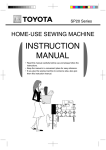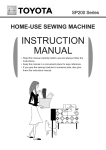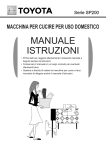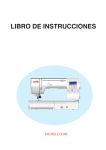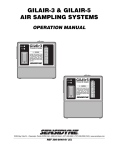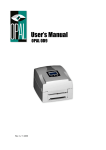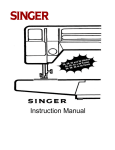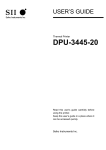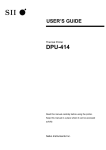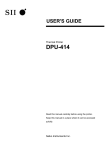Download Toyota SPB15 sewing machine
Transcript
SP10 Series HOME-USE SEWING MACHINE INSTRUCTION MANUAL • Read this manual carefully before use and always follow the instructions. • Keep the manual in a convenient place for easy reference. • If you give the sewing machine to someone else, also give them this instruction manual. Contents Before use • • • • • • • • Sewing preparations • • • • • • • • • • Sewing Straight stitching and reverse sewing ............................. 25 Zigzag sewing ................................................................. 28 Adjusting thread tension ................................................. 30 Buttonhole sewing .......................................................... 31 Overcasting ..................................................................... 34 Zipper insertion ............................................................... 35 Blind hem stitching.......................................................... 37 Maintenance • • • • Sewing preparations Connecting the power ..................................................... 12 Installation of battery for winding the lower thread .......... 13 Winding the lower thread ................................................ 14 Threading the lower thread ............................................. 16 Threading the upper thread ............................................ 17 Pulling up the lower thread ............................................. 19 Application of each stitch pattern .................................... 20 Changing the presser foot............................................... 21 Changing the needle....................................................... 23 Relationship between the needle, thread and fabric, and adjusting the thread tension .......................... 24 Sewing • • • • • • • Before use Important safety instructions ............................................. 4 How to change the power plug ......................................... 6 Part names ....................................................................... 8 How to use handwheel ................................................... 10 How to use presser foot lever ......................................... 10 How to use reverse sewing lever .................................... 10 How to remove extension table ....................................... 10 How to use quick adviser ................................................ 11 Feed dog and hook maintenance ................................... 39 Changing light bulb ......................................................... 41 Troubleshooting............................................................... 42 Servicing double-insulated products (230V-240V) .......... 44 Others • Safety precaution about the battery ................................ 44 • Recycling ....................................................................... 45 • Specifications.................................................................. 46 Maintenance Others Before use • Be sure to read this section before use Important safety instructions These safety instructions are designed to prevent danger or damage arising from the incorrect operation of the machine. Read carefully and always follow the instructions. Explanation of “ Warning” and “ Caution” Warning An incorrect operation could result in death or serious injury. Caution An incorrect operation could result in an injury or damage to the machine. Symbol explanation Do not touch. Prohibited actions Required actions Remove the power plug from the outlet. Warning Use an AC 220 to 240 V power source. Not doing so could cause an electric shock or a fire. Do not damage the power cord, modify it, bend it excessively, jerk it or twist it. Doing so could cause an electric shock or a fire. If the power cord is damaged, it must be replaced by a special cord or assembly available from the manufacturer or its service agent. Do not use outdoors. Doing so could cause an electric shock or a fire. Do not operate where aerosol ( spray ) products are being used or where oxygen is being administered. Doing so could cause a fire. Caution 4 When the machine is not in use it should be stored safely, not on the floor as protruding parts could cause injury if a person fell on the machine. Not doing so could cause an injury. Caution Remove the power plug from the outlet when replacing the needle, presser foot, setting the upper or lower thread. Not doing so could cause an injury. Do not look away from the needle while operating the sewing machine. If the needle breaks it could cause an injury. Do not touch moving parts such as the needle, take-up lever or handwheel. Doing so could cause an injury. Children should only use the machine under the supervision of a parent or guardian. Otherwise they could injure themselves. Do not use when young children are near the machine. They could touch the needle and be injured. When leaving the sewing machine after use, remove the power plug from the outlet. Not doing so could cause an injury. Before using the sewing machine make sure that the presser foot holder clamp screw, needle clamp screw and needle plate screw are firmly tightened, and that the presser foot is properly set in the presser foot holder. Not doing so could cause an injury. Do not perform the following actions. Doing so could cause an injury. • • • • • Sewing without lowering the presser foot. Sewing while the needle is incorrectly installed. Using a bent needle. Sewing while jerking the fabric. Moving the pattern selection dial while sewing. Do not operate on an unstable surface such as a sofa or a bed. If the sewing machine falls down, it could cause an injury or damages to the machine. Do not drop or insert any foreign objects into any openings such as opening space when you remove the face cover and / or the outer casing space of bobbin case. Doing so could cause an injury or damages to the machine. Do not repair, disassemble or modify except what is mentioned in the instruction manual. Doing so could cause an electric shock, a fire or an injury. 5 Before use UK ONLY • IMPORTANT PLEASE READ CAREFULLY How to change the power plug Warning When you change the power plug or cord, do not repair, disassemble or modify except at the authorised dealer or service centre. Doing so could cause an electric shock or a fire If for any reason the power plug for this product is removed it should be immediately disposed of safety and not stored anywhere where it could be inadvertently used again. Doing so could cause an electric shock or a fire The wires in this mains lead are coloured in accordance with the following code: BLUE-NEUTRAL BROWN-LIVE ( OR ACTIVE ) As the colours of the mains lead of this appliance may not correspond with the coloured markings identifying the terminals in your plug - PROCEED AS FOLLOWS: The earth plug pin is unnecessary. As the machine is designed under double insulation structure, the earth wire is removed from the machine. The wire coloured BROWN must be connected to the terminal marked L or A or coloured RED. The wire coloured BLUE must be connected to the terminal marked N or coloured BLACK. Neither core is to be connected to the earth terminal of a three-pin plug. 6 • Memo 7 Before use • Part names • External appearance may differ from model to model. Upper thread tension dial Spool pin Thread guide Quick adviser Take-up lever Pattern selection dial Light bulb Face cover Reverse sewing lever Extension table (Accessory Box) Needle clamp screw Needle thread guide Presser foot holder Needle plate Presser foot holder clamp screw Feed dog Presser foot Bobbin case cover 8 Bobbin case Thread winding spindle Thread winding switch Hollow for carrying ( Insert your hand to the hollow when carrying sewing machine ) Presser foot lever Handwheel Terminal box Thread cutter Buttonhole adjustment screw Battery holder Foot controller 9 Before use • How to use handwheel Handwheel Always turn the handwheel towards yourself. (in the direction of the arrow, forwards) Note: If you turn it in the reverse direction it could tangle the thread. • How to use presser foot lever • When sewing, lower the presser foot lever to lower the presser foot. (Position 1) • When inserting fabric, lift up the presser foot lever to raise the presser foot. (Position 2) • When inserting very thick fabric under the presser foot, the lift height can be increased by holding the presser foot lever at this position. (Position 3) • How to use reverse sewing lever • While lowering the reverse sewing lever, reverse sewing is performed. • Remove your finger from the reverse sewing lever to return to forward direction sewing. • How to remove extension table Pull out the extension table (accessory box) in the direction of the arrow. Extension table 10 Before use • How to use quick adviser This quick adviser describes basic countermeasures about the main troubles. Meaning of the illustrations Illustrations of the troubles Section of countermeasures Meaning of the illustrations • Jammed stitches • Unbalanced stitches • The fabric wrinkles/puckers • Missed stitches Above troubles happen, refer to illustration A for countermeasures. Meaning of the illustrations A When needle is broken, refer to illustration B for countermeasures. B When you want to know how to attach presser foot, refer to illustration C for countermeasures. When you want to know how to wind lower thread, refer to illustration D for countermeasures. Describes below 3 operations. 1 Adjusting thread tension. 2 Threading the lower thread correctly. 3 Threading the upper thread correctly. Describes how to change needle correctly. 1 Raise the needle. 2 Remove the needle. 3 Attach the new needle. C Describes how to attach presser foot. 1 Raise the presser foot lever. 2 Set the presser foot under the presser foot holder correctly. 3 Lower the presser foot lever. D Describes how to install battery for winding lower thread. 1 Install the battery into battery holder on the back of sewing machine. 2 Push the switch to the left. 11 Sewing preparations • Connecting the power Warning Do not touch the power plug with wet hands. Doing so could cause an electric shock. Pull the part of plug when removing the power plug. Not doing so could damage the cord and cause an electric shock, fire or injury. 1 Prepare the foot controller. 2 Insert the power cord connector into the terminal box. 3 Insert the power plug into the outlet. The power is turned on. Power plug Foot controller Terminal box Connector How to operate foot controller Step on the foot controller to operate the sewing machine. The more you press the foot controller, the faster the machine runs. Release the foot controller to stop the machine. 12 Foot controller Sewing preparations • Installation of battery for winding the lower thread A battery is supplied as one of the accessories. Before winding the lower thread, install it in the battery holder on back of sewing machine. Attention 1 When the machine is not used for a extended period remove the battery. Battery holder Pull the battery holder cover out as the arrow. Battery holder cover 2 Install the battery while confirming polarity of it. Attach battery holder cover. Note: Refer to page 42, 43 when purchasing or changing batteries. 3 Make sure that the thread winding spindle rotates by turning the thread winding switch on by pushing in the direction of arrow. Note: Thread winding spindle rotates while pushing the switch to the left. Thread winding switch 13 Sewing preparations • Winding the lower thread The exclusive motor driven by a battery winds the lower thread. Caution Be careful not press foot controller when winding the lower thread. Doing so could cause an injury. Do not touch the lower thread winding spindle when winding the lower thread. Doing so could cause an injury. Attention Use a TOYOTA-exclusive bobbin. 3 1 Pull up the spool pin. 2 Position the felt, the thread spool and the spool cap on to the spool pin. Note: A felt was originally put on to the spool pin. 3 14 Pull the thread from the thread spool. Support the thread on the sewing machine with one hand, using the other hand pass the thread around the thread guide as shown in the diagram. 1 2 4 5 6 7 8 9 10 11 Spool cap Felt 4 Pass the thread end through the hole of the bobbin as shown. 5 Place the bobbin on to the thread winding spindle so the groove will meet the shaft projection. Thread Hole Groove Thread winding spindle 6 Hold the thread end and push the thread winding switch to the left and start winding. 7 After winding a little, release the thread winding switch to the right and stop winding. Shaft projection Note: While pushing the winding switch to the left, thread winding spindle rotates. 8 Cut extra thread above the bobbin hole. 9 Push the thread winding switch to the left again. Wind the thread in the amount you need. 10 To stop winding, release the thread winding switch to the right. Attention Do not wind excessively, it causes sewing malfunction. right 11 wrong Remove the bobbin from the spindle. Cut the thread. 15 Sewing preparations • Threading the lower thread Caution 1 Remove the power plug from the outlet when setting the bobbin. Not doing so could cause an injury. Take off the bobbin case cover by sliding it towards yourself. Pull bobbin case cover forward and lift to remove. Bobbin case cover 2 Insert the bobbin into the bobbin case, so it rotates counterclockwise. Note: Inserting the bobbin in the wrong direction causes irregular thread tension. 3 Pull the end of thread through the cut-out guide a to guide b of the bobbin case and pull out in direction of arrow. Bobbin case a b 4 Groove Pull back end of thread about 15cm. Projection Put bobbin case cover projections into the race retainer grooves and push closed. Groove Projection 16 Sewing preparations • Threading the upper thread Caution 1 Remove the power plug from the outlet when threading the upper thread. Not doing so could cause an injury. Line on handwheel should be up position.(12 o’clock) 2 Take-up lever Turn handwheel towards yourself to raise take-up lever. Line Raise presser foot lever. Note: If the presser foot lever is not raised, the thread can not be threaded correctly. Presser foot lever 3 Pull up the spool pin. 4 Position the felt and the thread spool. Felt Note: A felt was originally put on to the spool pin. 5 Pull the thread from thread spool. Support the thread on the sewing machine with one hand, using the other hand pass the thread around the thread guide as shown in the diagram. Thread guide 17 6 Pass the thread between the thread guide plate and the upper thread tension dial. Upper thread tension dial Thread guide plate 7 Pass the thread along the groove of the thread guide plate, as the arrow in the diagram. Pass the thread through the take-up lever. 8 Pass the thread through the right side needle guide. Check that the thread is threaded correctly. Raise the presser foot and pull the upper thread towards yourself. The thread should pull out smoothly. Lower the presser foot and pull the upper thread towards yourself. It should be resistant and difficult to pull. 9 Take-up-lever Needle guide Pass the thread through the needle eye from the front. Pull back about 15 cm. Front 15cm 18 Sewing preparations • Pulling up the lower thread 1 Hold the end of the thread, turn the handwheel towards yourself for one full turn, and stop when the needle is at its highest position. Handwheel Note: Always turn the handwheel towards yourself (in the direction of the arrow). If you turn it in the wrong direction it could tangle the thread. Note: If the thread is tight the lower thread will not come out, so hold the thread loosely. 2 Pull up the upper thread and the loop of the lower thread will come out. Pull out this lower thread. Upper thread 3 Lower thread Align the upper thread and lower thread, and thread through the groove of the presser foot. Pull back about 15 cm. 15cm 19 Sewing preparations • Application of each stitch pattern Caution Don’t turn the pattern selection dial while operating the sewing machine. Doing so could cause an injury. Turn the handwheel towards yourself to raise the needle in the highest position. Turn the pattern selection dial to choose the pattern. Pattern selection dial 20 Buttonhole Blind hem stitch Zigzag Applique Overcasting Scallop stitch Straight stitch Sewing-seams Zipper insertion Castle stitch Thin fabric straight stitch Decorative stitch Fagotting Mending stitch Thin fabric overcasting Decorative stitch Serpentine Sewing preparations • Changing the presser foot Remove the power plug from the outlet when changing the presser foot. Not doing so could cause an injury. Caution Removal 1 Raise the presser foot lever. 2 Turn the handwheel towards yourself to raise the needle. Note: Never turn in the wrong direction. Handwheel Presser foot lever 3 Press the presser foot holder lever in the direction of the arrow to release the presser foot. Presser foot holder lever Presser foot 21 Installation 1 Position the presser foot pin directly below the groove in the presser foot holder. Presser foot holder Groove 2 22 Lower the presser foot lever to secure the presser foot. Presser foot pin Presser foot lever Sewing preparations • Changing the needle Remove the power plug from the outlet when changing the needle. Not doing so could cause an injury. Caution Broken needles are dangerous. Be sure to dispose of them in a safe place away from children. Not doing so could cause an injury. 1 2 Turn the handwheel towards yourself to raise the end of the needle higher than the needle plate. Screw driver for the needle plate Hold the needle in one hand, loosen the needle clamp screw with the screw driver for the needle plate, and remove the needle. Needle clamp screw Note: Do not remove the needle clamp screw. Loosen the needle clamp screw to remove the needle. 3 Face the flat surface of the needle to the rear and insert until it makes contact with the pin. Firmly tighten the needle clamp screw with the screw driver for the needle plate. Flat surface Pin Correct needle selection Good needle If a faulty needle is used, not only could it impair the sewing performance, but it could also damage the needle plate or hook, or break the needle. Incorrect stitching or thread breaking, try replacing the needle. ∗ Faulty needle The entire needle is bent The point of the needle is crushed / worn away The point of the needle is bent 23 Sewing preparations • Relationship between the needle, thread and fabric, and adjusting the thread tension Adjusting the thread tension Relationship between the needle, thread and fabric The quality of the sewing finish will improve if the needle and thread are changed to match the type of fabric. Follow the directions in the table below. Sewing thin fabric Sewing normal fabric Sewing thick fabric No. 75/11 No. 90/14 No. 100/16 Needle Thread Fabric Polyester No. 50 to No. 60 Polyester No. 30 to No. 50 Polyester No. 90 Cotton No. 40 to No. 50 Cotton No. 80 to No. 120 Cotton No. 60 to No. 80 Silk No. 50 to No. 80 Silk No. 50 Silk No. 80 Normal back cloth Quipler Georgette Lawn Lace, etc. -3 Thread tension Normal front cloth Broad Soft denim Satin Pile Gingham, etc. -1 Curtains Denim Quilting Fleece Tweed Felt, etc. +1 +2 -2 -1 -1 ~ -3 +1 +3 +2 +4 +1 ~ +3 • Use a ball point needle for the sewing alignment of stretch fabric. • Please purchase any needles not included as accessories, after checking they are specified as home-use sewing machine needles. • Use the same kind of threads for upper/lower thread. • The bigger the needle number is , the thicker the needle is, the bigger the thread number is, the thinner the thread is. 24 Sewing • Straight stitching and reverse sewing Caution Do not pull the fabric excessively while sewing. Doing so could break the needle and cause an injury. Straight stitch 1 Turn the handwheel towards yourself to raise the needle. 2 Turn the pattern selection dial to choose the pattern. Zigzag sewing foot (Originally attached to the sewing machine) 7 4.0 3 8 2.0 9 2.0 mm Position the fabric and lower the presser foot lever. Step on the foot controller to begin sewing. End of sewing After sewing, turn handwheel towards yourself until the needle is in the highest position. Raise the presser foot and pull out the fabric to the rear. 25 Thread cutter on the presser bar Line up two threads and cut with the thread cutter on the presser bar. Thread cutter Reverse sewing Reverse sewing is performed at the beginning and the end of sewing to prevent the thread from unraveling. Reverse sewing is performed while pressing down the reverse sewing lever. • Stitch 1 cm from the edge of the fabric to prevent unraveling at the start of sewing. • Sew 3 to 4 reverse stitches at the end of sewing. Note: Remove your finger from the reverse sewing lever to return to forward direction sewing. 26 Reverse sewing lever Sewing thick fabric When sewing thick fabric from the edge, the presser foot may tilt and be unable to feed through the fabric. Place fabric or thick paper of the same thickness as the fabric you wish to sew under the presser foot. This will enable smooth sewing. Fabric or thick paper Sewing fabric Sewing thin fabric When sewing thin fabric, sometimes fabric puckers or is not fed correctly. At that time, sewing is easier if tissue paper is placed under the fabric. After sewing remove the paper carefully. Tissue paper 27 Sewing tube-shaped fabrics 28 1 Pull out the extension table (accessory box) in the direction of the arrow. 2 Sew tube-shaped fabrics such as trousers or sleeves, by pulling them over the machine free arm as shown in the diragram. Sewing • Zigzag sewing There are various zigzag applications, such as applique and overcasting. 1 Turn the handwheel towards yourself to raise the needle. 2 Turn the pattern selection dial to choose the pattern. Zigzag sewing foot (Originally attached to the sewing machine) 5 2.5 3 6 5.0mm Position the fabric and lower the presser foot. Step on the foot controller to begin sewing. 29 Sewing • Adjusting thread tension Straight stitch Upper thread is tight Wrong side Adjustment method for upper thread tension zUpper thread is tight Right side Upper thread is loose Wrong side Lower the upper thread tension. Right side zUpper thread is loose Zigzag sewing Upper thread is tight Right side Wrong side Increase the upper thread tension. Upper thread is loose Right side Note: If the tension does not change even when you adjust the upper thread tension, thread the upper thread and lower thread again. Wrong side 30 Sewing • Buttonhole sewing Buttonhole sewing to match the size of the button is possible. For stretch fabric or thin fabric, it is recommended to use a stabilizer for a better buttonhole finish. Caution 1 Remove the power plug from the outlet when changing the presser foot. Not doing so could cause an injury. Change to the buttonhole foot. (Refer to “Changing the presser foot”, p19.) 1 2 3 4 Buttonhole foot Center line Set the buttonhole size and mark lines on the fabric. 3mm Buttonhole size 2 Start line of sewing Button thickness (Button diameter+button thickness+3mm) 3 Align the buttonhole foot division line closest to you with the guide line, and lower the presser foot to the start line of sewing on the fabric. Division line Start line of sewing Guide line Center line 31 32 4 Raise the needle to the highest position, set the pattern dial to “1”, sew the left side and stop at the line marked on the fabric. 5 Raise the needle to the highest position, set the pattern dial to “2”, and sew 5 to 6 bar-tack stitches. “2” and “4” on the pattern selection dial use the same dial position. 6 Raise the needle to the highest position, set the pattern dial to “3”, sew the right side and stop at the line marked on the fabric. 7 Raise the needle to the highest position, set the pattern dial to “4”, and sew 5 to 6 bar-tack stitches. Caution 8 When using the buttonhole cutter to cut the buttonholes, do not hold the fabric in front of the cutter. Doing so could cause an injury to your hand. Use the buttonhole cutter to cut the center, making sure not to cut the stitches. Note: If a marking pin is put in the bar-tack area it helps to prevent cutting the bar-tack with the buttonhole cutter. Adjustment of buttonhole balance • Use the buttonhole adjustment screw to adjust the balance between the stitches (rear side). • Adjust by turning with the - screw driver of your own. • Don’t turn the screw more than 90°. Note: The original position of buttonhole adjustment screw may vary according to the model of machine. Buttonhole adjustment screw If the stitches are loose on the right side of the buttonhole, turn slightly in the “-” direction. If the stitches are loose on the left side of the buttonhole, turn slightly in the “+” direction. 33 Sewing • Overcasting 1 This is a sewing method that prevents unraveling at the edge of the fabric. Select one pattern from No.5, No.6 and No.10. Note: Select pattern No.10 when sewing thin fabric. Zigzag sewing foot (Originally attached to the sewing machine) 2 34 Position the fabric so that the right needle entry point at the edge of the fabric is slightly on the outside. 5 Right needle entry point 6 10 Sewing • Zipper insertion Caution Remove the power plug from the outlet when changing the presser foot. Not doing so could cause an injury. First sew the left side of the zipper. 7 8 Zipper foot 4.0 2.0mm Sewing the left side of the zipper 1 Set the right side pin of the zipper foot to the presser foot holder. 2 Align the zipper and the fabric, and tack. 3 Position the fabric so that the zipper is on the right side of the presser foot. Left side pin Right side pin Tack Zipper 35 4 Sew until just before the presser foot makes contact with the slider, and then stop the sewing machine. Slider 5 Turn the handwheel towards yourself to lower the needle into the fabric. 6 Raise the presser foot. 7 Move the slider to the rear of the presser foot, and finish the sewing. Slider Sewing the right side of the zipper Release the presser foot and set to the left side pin. Sew the right side of the zipper using the same procedures as for the left side. Note: Sewing in the same direction as the left side will help prevent sewing misaligment. 36 Sewing • Blind hem stitching In this sewing method the stitch cannot be seen on the front of the fabric. Zigzag sewing foot (Originally attached to the sewing machine) 1 Fold back the cloth so that the folded area protrudes by about 5 to 7 mm. 2 Iron and tack by hand. 11 Tacking Wrong side Right side 5 to 7 mm 3 4 5 Position the cloth so that the left side stitch catches 1 or 2 threads of the inside fold. Lower the presser foot and start sewing. Sew evenly so that small stitches are evenly located on the right side. After sewing, pull out the tacking, open out the fabric. Inside fold Wrong side Wrong side Right side 37 Balanced stitches Wrong side Right side Small stitches evenly located on right side. 38 Needle catches too much on the fold Wrong side Right side Large stitches on right side. Needle does not catch on the fold Wrong side Right side The blind hem stitches do not come through Maintenance • Feed dog and hook maintenance If the sewing machine makes a loud noise or rotates slowly, or there could be thread waste or dust in the hook or feed dog. Perform maintenance on the hook and the feed dog. Caution When cleaning the hook, disconnect the power plug. Not doing so could cause an injury. Attention Do not use detergent, bleach, benzine, or thinner chemical cloths. Doing so could cause discoloration or cracking. Cleaning the feed dog and hook 1 Remove presser foot and needle. Loosen screws of needle plate with screw driver for the needle plate and take off needle plate. Presser foot 2 Lift bobbin case in the direction of the arrow and remove it. Bobbin case 3 Brush off lint and dust on feed dog and hook, then clean it with a soft cloth. A vacuum cleaner wand or hose may be used to remove lint from this area. Feed dog Hook 39 Attaching the Bobbin Case 1 Install the bobbin case from the front. The red mark a on the bobbin case should be in the position, as shown in the diagram. a 2 3 Align the red mark a and b, and attach the needle plate with the projection c on the bobbin case positioned as shown in the diagram. b a b a Make sure that bobbin case moves slightly from side to side as indicated by the arrow. Needle plate c 4 Tighten needle plate clamp screws. Turn the handwheel and see if hook moves smoothly. When the bobbin case is attached incorrectly, the handwheel is heavy and does not turn smoothly. At that time remove the needle plate and the bobbin case, attach them again. Attach the needle and presser foot. Make sure that the needle goes into the hole of needle plate correctly while turning the handwheel towards yourself. 40 Maintenance • Changing light bulb Warning 1 When changing the light bulb, disconnect the power plug and wait until the bulb cools. Not doing so could cause a burn or electric shock. Loosen the screw with a “+” screw driver of your own, and take off the face cover in the direction of the arrow. Screw Face cover 2 Turn the light bulb counterclockwise as the arrow in the diagram and remove. 3 Turn the new light bulb clockwise to install. Note: Use a light bulb with a maximum power of 15 W. 4 Always reinstall the face cover after replacing the light bulb. 41 Maintenance • Troubleshooting Trouble Does not rotate Does not work Loud noise Slow rotation Broken needle Broken upper thread Broken lower thread Fabric not fed through 42 What is the problem? Check the following possibilities before contacting the service center for repair. Cause Countermeasure Page The power plug is not inserted Connect the power plug correctly 10 Thread is tangled in the hook, or there is a broken needle in the hook Clean the hook 37 There is thread waste or dust in the hook or feed dog Remove thread waste or dust 37 The needle is incorrectly installed Install the needle correctly 21 The needle clamp screw is loose Firmly tighten the screw 21 The needle is too fine for the cloth Use a needle appropriate to the fabric 22 The tension of the upper thread is too tight Adjust the thread tension 28 The fabric is being pulled too strongly Do not pull the fabric strongly 23 The bobbin case is not in the correct position Put the bobbin case in the correct position 38 The upper and lower thread are not correctly threaded Thread the upper and lower thread 14, 15 The thread is tangled in the bobbin case or hook Remove thread waste from the feed dog and hook 37 The tension of the upper thread is too tight Adjust the thread tension 28 The needle is bent The point of the needle is burred Use a good needle 21 The lower thread is incorrectly threaded Thread the lower thread 14 There is thread waste in the feed dog Remove thread waste from the feed dog and hook 37 The pattern selection dial is set to “2” or “4” Set a correct pattern 18 Trouble Missed stitches The fabric wrinkles / puckers Too much lower thread showing on right side of the fabric Too much upper thread showing on wrong side of the fabric Cause Countermeasure Page The needle is incorrectly installed Install the needle correctly 21 The needle is bent Use a straight needle 21 The needle and thread are not appropriate for the fabric Sew with a needle and thread appropriate to the fabric 22 The upper thread is not correctly thread Thread the upper thread correctly 15 The tension of the upper thread is too tight Adjust the thread tension 28 The upper and lower thread are not correctly thread Thread the upper and lower thread again The needle is too thick for the cloth Use a needle appropriate to the fabric 22 The needle is burred Use a good needle 21 The lower thread is incorrectly threaded Thread the lower thread again 14 The tension of the upper thread is too tight Adjust the thread tension 28 The bobbin is not correctly inserted in the bobbin case Insert the bobbin in the bobbin case correctly 14 The upper thread is not correctly threaded Thread the upper thread correctly 15 The tension of the upper thread is too loose Adjust the thread tension 28 The upper thread is not correctly threaded (not threaded through the thread guide) Thread the upper thread correctly 15 14, 15 If the above treatments do not solve the problem, contact the service center as described in your warranty. When calling for service, please note the MODEL and SERIES that are inscribed on the back of your sewing machine. SP10 SERIES / SERIE MODEL / MODELE Manufacturer/ : ZHEJIANG AISIN ELITE Fabricant MACHINERY & ELECTRIC CO., LTD.P.R.C. 220-240V Total 85W 50Hz max 15W Importer/ : Importateur EUROPE S. A. Designed and engineered by AISIN SEIKI JAPAN MADE IN P. R. C. / FABRIQUE A P.R.C. 43 Maintenance / Others • Servicing double-insulated products (230V-240V) In a double-insulated product, two systems of insulation are provided instead of grounding. No grounding means are provided on a double-insulated product nor should a means for grounding be added to the product. Servicing a double-insulated product requires extreme care and should only be done by qualified service personnel with knowledge of the system under his or her responsibility. Replacement parts for a doubleinsulated product must be identical to those parts in the product. The symbol is marked on the double-insulated product. Others • Safety precaution about the battery Warning If the alkaline solution from the battery should get in the eyes or come into contact with the skin or clothes, rinse with a large quantity of clean water and consult a doctor immediately. Not doing so could cause an injury. Caution 1. Do not short-circuit, disassemble, heat, recharge, deform, dispose of in fire. 2. Do not insert batteries in reverse polarity. 3. Do not expose batteries to strong impact by dropping or throwing the batteries. Doing so could cause a leakage of alkaline solution. 44 Others • Recycling DO NOT THROW AWAY! EU ONLY We are committed to the protection of the environment. We strive to minimize the environmental impact of our products by continuously improving product design and our manufacturing methods. At end of life please dispose of this product in an environmentally responsible way. The crossed-out wheelie bin symbol featured above and on the product’s data-plate means that this product falls under the scope of the E.U. “Waste Electrical and Electronic Equipment” (WEEE) directive and “Restriction of the Use of Certain Hazardous Substances in Electrical and Electronic Equipment” (ROHS) directive and should not be disposed of with your household waste. At end of life, you must ensure that this product is disposed of in accordance with national and local legislation and that it is sorted as Category 2 “Small Domestic Appliances” WEEE. You may be liable under local and national laws for improper disposal of this product. Please consult the web, or a competent national or local body, for the return and collections systems available to you and the locations of your nearest recycling points. If you purchase a new product direct from us we will take your old product back, irrespective of the brand, if it is a like for like sale. As an individual you can make a positive impact on reuse, recycling and other forms of recovery of WEEE. This will reduce use of landfill and minimize the environmental impact of the products you use. Hazardous substances in electronic and electrical products can have a harmful impact on human health and on the environment. 45 Others • Specifications Model SP10 series Hook type Horizontal Needle Home-use sewing machine needle (HA-1) Bobbin TOYOTA-exclusive plastic bobbin Maximum stitch length 4 mm Maximum stitch width 5 mm Standard needle position Center standard, left standard Sewing machine weight (main unit) 6.3 kg Sewing machine size Width: 412 mm Depth: 192 mm Height: 292 mm Rated voltage 220 - 240 V Rated frequency 50 Hz Rated power consumption 85 W Light bulb 15 W Battery Alkaline 1.5 V, Mignon/AA/LR6 If you have any queries about this TOYOTA sewing machine, check the warranty for details. 46 EU ONLY Imported by / Importé par : Head Office Web: www.home-sewing.com Avenue de l’Industrie 21, Parc Industriel, 1420 Braine-L’Alleud BELGIUM TEL: +32 (0) 2 387 0707 FAX: +32 (0) 2 387 1995 UK Branch Unit 4, Swan Business Park, Sandpit Road, Dartford, Kent, DA1 5ED UK. TEL: +44 (0) 1322 291137 FAX: +44 (0) 1322 279214 Bât. Le Minnesota, allée Rosa Luxembourg, B.P.70294, 95615 Cergy Pontoise Cedex, FRANCE France Branch TEL: +33 (0) 1 34 30 25 00 FAX: +33 (0) 1 34 30 25 01 Germany Branch Odenwaldstrasse. 3, D-63263 Neu-lsenburg, GERMANY TEL: +49 (0) 61 02-3 67 89-0 FAX: +49 (0) 61 02-3 67 89-13 Holland Branch Energieweg 14, 2382 NJ Zoeterwoude (Rijndijk), THE NETHERLANDS TEL: +31 (0) 71 5410251 FAX: +31 (0) 71 5413707 Austria Branch Donaufelderstrasse 101/5/1, A-1210 Wien, AUSTRIA TEL: +43 (0) 1 812 06 33 FAX: +43 (0) 1 812 06 33-11 679111-DBA10-D
















































